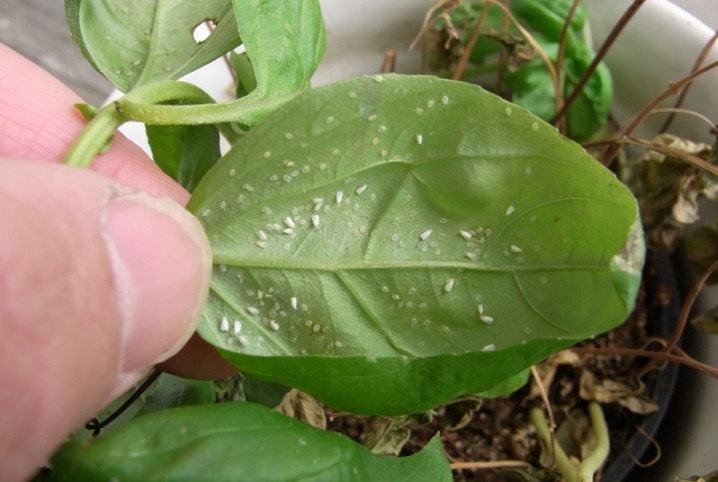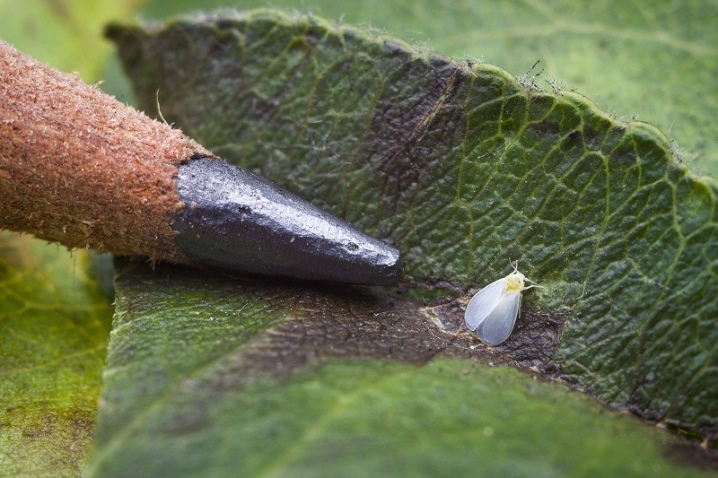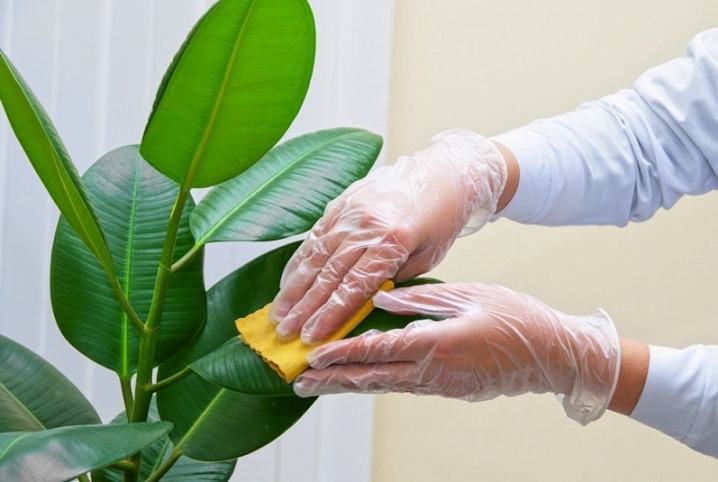Whitefly on indoor plants: how to get rid of?

Whitefly is a pest that often appears on horticultural crops and indoor plants. It is quite difficult to get rid of it - for this they resort to folk methods and the use of powerful insecticidal agents. If appropriate measures are not taken in time, the plant may die. What to do if a whitefly appears, and how to reduce the risks of its occurrence, we will consider in this article.

Reasons for the appearance
Whitefly really likes the stale atmosphere, high air temperature (at least + 20 ° С). She "loves" densely planted plants. All these factors often attract the parasite. As adults fly, they can easily enter the apartment through an open window.
Another way of infecting indoor plants is through the soil. The fact is that the eggs of the whitefly, which are in the ground, calmly tolerate the cold. They do not die in winter at subzero temperatures and can be brought along with the soil. Once in favorable conditions, they begin to actively develop and multiply on indoor plants.
Whiteflies can be brought into an apartment or house along with cut garden flowers. And also the reason for the appearance is often a new diseased plant that was brought into the room. After a short time, the pest begins to attack healthy crops. These parasites readily spread on violets, gerberas, hydrangeas and begonias, which is why these flowers need to be examined regularly with special care.


Signs of infection
There are a number of signs that the whitefly has appeared on green domestic pets. Let's figure out how to recognize the enemy in order to take timely measures and save the plant from death.
- The appearance of small flies on vegetation. They can fly or jump from leaf to leaf. If you do not start pest control, over time, when plants are touched, insects will fly up, forming a "cloud".
- Translucent scales appear on the back of the leaf - this is what the larvae of adults look like.
- Formation on plants of a shiny plaque with a sticky consistency. These are the waste products of insects.
- If you do not pay attention to the midges that have appeared for a long time, the leaves of the plants suffer - they turn yellow, begin to curl and soon fall off.


Home growers also note that dark spots often form on the leaves. This is a sooty mushroom, the occurrence of which is provoked by the waste products of whiteflies. Diseased flowers look lethargic and may stop growing or stop blooming.
Please note: the greatest harm to indoor plants is caused not by adult insects, but by larvae. While developing, they absorb large amounts of nutrients from plant crops.
During the transformation of the larva into a moth, the plant can be destroyed.

Description of species
In nature, there are over 2 hundred whiteflies. Previously, they lived only in areas with a warm climate, but over time they spread almost everywhere. Insects attack plants in open ground, in greenhouses or in homes. Such parasites look as small white flies with wings, visually resembling moths. Females reach a size of 2 mm, and the length of males ranges from 2.5 to 3 mm. The wings and body of insects are covered with white waxy pollen.
Mostly indoor plants are affected by several species of whiteflies.
- Tobacco (sometimes called cotton). This insect is one of the smallest - its length reaches 1.5 mm. Antennae, body and legs are yellow, wings are white. Adults are covered with a whitish bloom. This South Asian parasite carries numerous infectious diseases.
- The greenhouse whitefly is native to South America. The length of most adults reaches 1.5 mm; larger specimens are less common. The body of the parasite is yellow, and the antennae are light brown in color. The wings are white, rough, with a whitish bloom.
- Citrus. Adults have a dark body, which is why they are also called black whiteflies. They affect not only citrus plants, but many others as well.
These insects are most common on the Black Sea coast.



The development of these species has 3 stages - egg, larva and imago. Adult females are capable of laying up to 20 green eggs up to 0.2 mm long at a time. If conditions are favorable, the insect can lay up to 300 eggs in a couple of weeks. After 1-2 weeks, transparent larvae appear. They attach to the leaves and, due to the piercing-sucking mouth apparatus, suck the sap from the plants. After another 2 weeks, the larvae turn into nymphs, which after the same time period turn into adults.


How to get rid of?
Whiteflies are found not only in the greenhouses on the backyard. Often they also infect indoor plants, so all lovers of flowers on windowsills need to know how to remove this parasite at home. There are several effective methods of dealing with it. Next, we will tell you in detail how to deal with such pests.
Chemicals
The use of special insecticidal agents is recommended in cases of severe damage to crops. First you need to make a thorough visual inspection of the plants. Infected flowers are recommended to be placed in a separate quarantine room. So the risks of damage to healthy plants will be minimized as much as possible. Using any drug, you must follow the dosage indicated by the manufacturer in the instructions. Plants should be treated with a respirator and gloves, and in the absence of children and pets.
Please note: it is not recommended to spray insecticides for prophylaxis on healthy flowers - if the solution gets on the foliage, the plant may weaken, stop growing and bloom.

The most effective drugs:
- "Spark" - the affected crops are sprayed with a solution and the soil is watered after cultivation (approximately 2 ml per liter of water);
- "Aktara" - a powerful drug recommended for severe lesions (capable of destroying both adults and larvae).
The following drugs are also considered effective against whitefly: "Vertimek", "Tanrek", "Mospilan", "Tiazipir" and others. Experienced gardeners advise adding a little shampoo to the solution - due to this, the chemical components "stick" better to the affected areas, due to which a greater effect will be achieved.


Biological agents
There are several drugs of biological origin that have been able to recommend themselves in the fight against whitefly. The most popular is Fitoverm. The tool belongs to the contact-intestinal. It is absorbed into the vegetable juice. By eating the leaves, the parasites die within 3 days. The pests will be destroyed if the drug gets on their body. To increase efficiency, a little liquid soap should be added to the solution, after which the cultures should be treated with it.
Another powerful, but very toxic drug - "Actellic"... He is able to destroy harmful moths in 4 days. When treating affected plants, be sure to use personal protective equipment (gloves, respirator). In order not to ruin the plants themselves, when using, you need to follow the instructions, excluding frequent use.
Biotlin Is another effective remedy recommended by experienced gardeners, gardeners and amateur flower growers.
The drug is toxic, therefore, during processing, you also need to take care of the effective protection of the respiratory organs.


Traditional methods
It is recommended to resort to folk methods of dealing with whitefly for small lesions. In addition, you can combine chemical methods for the destruction of "intruders" with folk. Among the advantages of such methods of struggle are noted:
- absolute safety for the health of households and pets;
- ease of preparation of solutions;
- efficiency.
Water with the addition of laundry soap is effective against whiteflies. Using a sponge and a mild soapy solution, the leaves are gently wiped from the outside in order to destroy the larvae. Thus, you need to "walk" through all the leaves. And also laundry soap can be grated and diluted with water (take in a ratio of 1: 6, respectively). Beat the resulting solution into a thick foam and apply with a sponge to the leaves of the plants.
Soapy solution can be sprayed from the spray bottle on the plants and the topsoil. It is important that the solution does not penetrate deeply into the soil.
If it was not possible to destroy the pests the first time, after 1 week it is recommended to repeat this treatment.

You can get rid of pests with the help of dandelion infusion. To prepare the solution, you need to take 40 grams of rhizomes and foliage of the plant and fill them with a liter of hot water. All this is aged for 4 days. The prepared solution is sprayed on foliage and the upper layers of the soil.
A solution of water and ammonia (1.5 liters of liquid for 5 drops of ammonia) will help to destroy the whitefly. In the resulting product, a sponge or cotton pad is moistened, each leaf of the plant is processed.
For adults, it is recommended to use special traps. For their manufacture, yellow cardboard is taken, since this color is especially attractive to parasites, and a long-curing adhesive composition. This trap must be placed in the pot using a wire. Adults will sit on the glue and stick. You can also buy a ready-made whitefly trap (the most popular are Bona Forte and Pheromone).
They are sold in flower or seed stores.



Fumigators
Fumigators against midges and mosquitoes will help to get rid of whiteflies. To reduce the parasite population, it is necessary to close the windows, insert a bottle of liquid or a plate into the device, and then plug it into an outlet. The closer the fumigator is to the houseplants, the more effective the insect control will be.
Important: to avoid poisoning, family members and animals should not be in a room with a fumigator plugged into an outlet.

Prevention measures
Thanks to regular preventive measures, the risks of whitefly appearing are reduced. Experienced growers are advised to keep the humidity in the room with flowers, not exceeding 50%. It is also important to drain the liquid from the trays that formed during the watering process. To avoid stale air in the apartment, the room should be regularly ventilated.
About once every few days, the plants should be carefully examined and shaken slightly. Twice a week it is necessary to gently wipe the leaves with a damp sponge or wet cotton pad. In addition, it is recommended to carefully examine the newly brought houseplants, and to acquire special soil for planting flowers.
Timely implementation of preventive measures can prevent the emergence and active reproduction of the whitefly.

You can find out the easiest way to breed a whitefly below.































The comment was sent successfully.